Determinants of the Energy Development Based on Renewable Energy Sources in Poland
Abstract
:1. Introduction
1.1. Literature Review
- The share of energy from renewable energy sources in the gross final energy consumption.
- The relationship between renewable energy sources and economic growth.
- Renewable energy consumption drivers.
1.2. International RES Initiatives and Regulations
1.3. Regulations and Policy for the Renewable Energy Sector in Poland
- The Act of 10 April 1997. The Energy Law, Journal of Laws of 1997 No. 54, item 348, with later amendments (consolidated text, Journal of Laws of 2020, item 261).
- The Act of 20 February 2015 on renewable energy sources, Journal of Laws of 2015, item 478, with later amendments (consolidated text, Journal of Laws of 2021, item 610).
- The Ordinance of the Minister of Economy of 4 May 2007 on detailed conditions for the functioning of the electricity system (Journal of Laws, item 623 and of 2008, items 178 and 1005, with later amendments).
- The Ordinance of the Minister of Energy of 6 March 2019 on detailed rules of shaping and calculating tariffs and settlements in electricity trade, Journal of Laws of 2019, item 503.
- Directive 2001/77/EC of the European Parliament and of the Council of 27 September 2001 on the promotion of electricity produced from renewable energy sources in the internal electricity market. Official Journal of the European Union, L 283, 27 October 2001.
- Directive 2003/30/EC of the European Parliament and of the Council of 8 May 2003 on the promotion of the use of biofuels or other renewable fuels for transport. Official Journal of the European Union, L 123, 17 May 2003.
- Directive 2009/28/EC of 23 April 2009 on the promotion of the use of energy from renewable sources and amending and subsequently repealing Directives 2001/77/EC and 2003/30/EC. Official Journal of the European Union, L 140/16; 5 June 2009.
- Directive 2010/75/EU of the European Parliament and of the Council of 24 November 2010 on industrial emissions (integrated pollution prevention and control) with later amendments.
- Directive (EU) 2018/2001 of the European Parliament and of the Council of 11 December 2018 on the promotion of the use of energy from renewable sources (recast).
- “Poland’s National Energy and Climate Plan for the years 2021–2030” (NECP PL) developed in fulfilment of the obligation set out in Regulation (EU) 2018/1999 of the European Parliament and of the Council of 11 December 2018 on the Governance of the Energy Union and Climate Action submitted to the European Commission on 30 December 2019.
- “Energy Policy of Poland until 2040” (PEP2040), prepared by the Ministry of Climate and Environment of 2 March 2021, Official Journal of the Republic of Poland (Monitor Polski, item 264).
- Reduction of CO2 emissions by 7% in non-ETS sectors (compared to 2005).
- 14% renewable energy share in transport.
- 21–23% RES share in gross final energy consumption.
- Increase to approx. 32% of RES share in electricity production.
- Increase by an average of 1.1 pp per year of RES share in heating and cooling.
2. Data and Methodologies
2.1. Research Design
2.2. Renewable Energy Sector in Poland in 2005–2019
- Primary energy consumption decreased by 1.6% per year between 2007 and 2014.
- Slight progress of the primary consumption since 2014 (0.4% per year), however, was about six times slower than the GDP rate of growth.
- Regular and rapid decrease in primary energy intensity of GDP since 2007 (−1.8% per year).
2.3. Variables Selection for Quantitative Analyses (2010–2019)
3. Results Based on Data for 2010–2019
3.1. Preliminary Results
3.2. Results Based on the Dynamic Panel Data Model
- The increase in total installed electric capacity (IEC) of connections affects the growth of RESS.
- The growth of household electricity consumption (HEC) is accompanied by the rise in RESS.
- The growth of nonhousehold electricity consumption (NEHC) affects the reduction of RESS.
4. Discussion
- The RE share in total energy production increased from 2.45% to 15.46% between 2005 and 2019. Likewise, RE share in energy consumption increased from 2.93% to 15.30%.
- The RE of voivodeships shares in total energy production (RESS) in 2010–2019 systematically increased in 9 out of 16 surveyed voivodeships. The largest shares in RE production are in voivodeships as follows: Warmińsko-Mazurskie, Podlaskie, Kujawsko-Pomorskie, Pomorskie, Zachodniopomorskie. The smallest share is in the Łódzkie and Śląskie voivodeships.
- Renewable energy in Poland is primarily produced from the incineration of biomass. In 2019, energy from biomass amounted to 65.56%, from wind farms 13.72%, from liquid biofuels 10.36%, from biogases 3.15%, from geothermal sources 2.96%, from solar production 2.96%, and from municipal waste 1.08%. The share of energy from hydroelectricity plants fell by more than a half over the period in question and reached 1.78%.
- The positive and statistically significant relationship between the power of installed facilities (IEC) and RES share in energy consumption.
- The rise in electricity consumption in households (HEC) causes an increase in the endogenous variable. This relationship is statistically significant.
- The negative and statistically significant relationship between electricity consumption of nonhousehold consumers (NHEC) and RES share in total energy consumption.
5. Conclusions
Author Contributions
Funding
Institutional Review Board Statement
Informed Consent Statement
Data Availability Statement
Conflicts of Interest
Appendix A

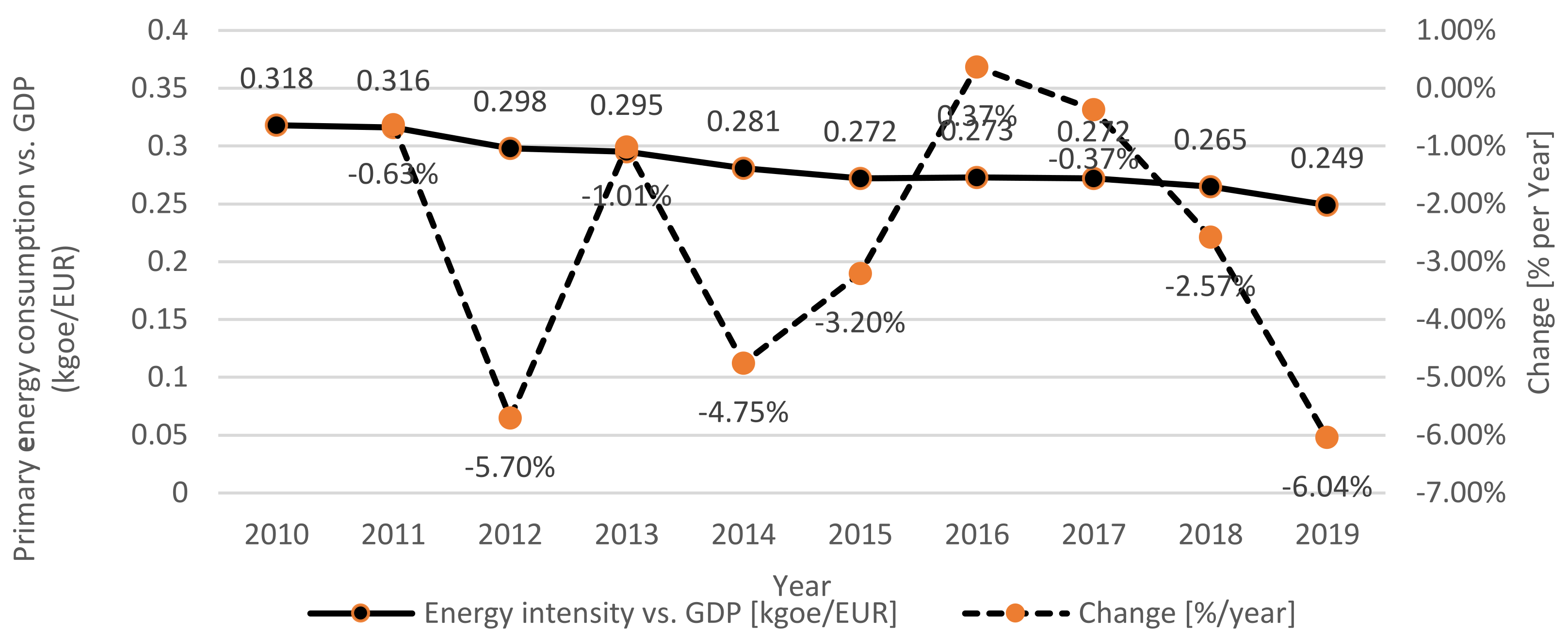
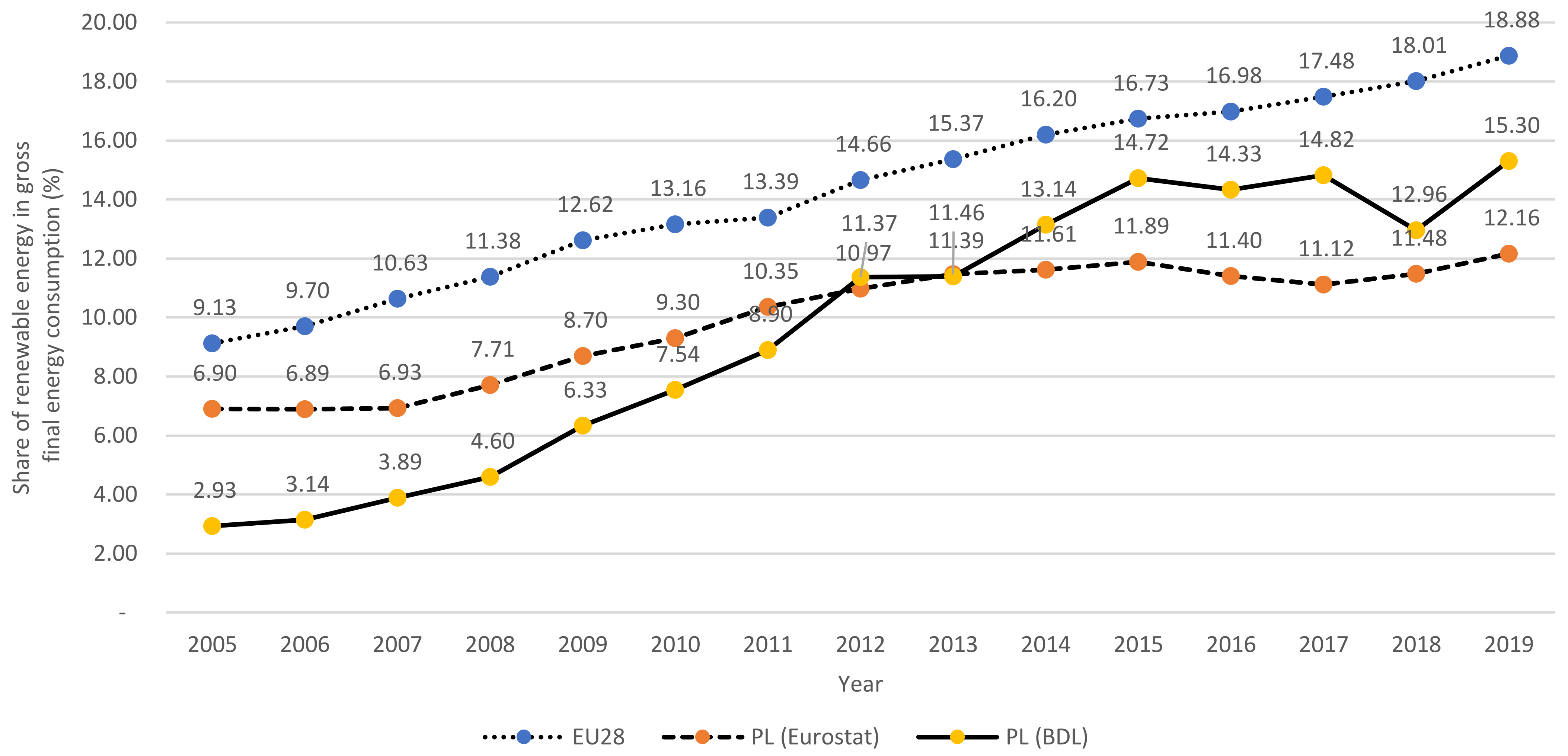
Appendix B
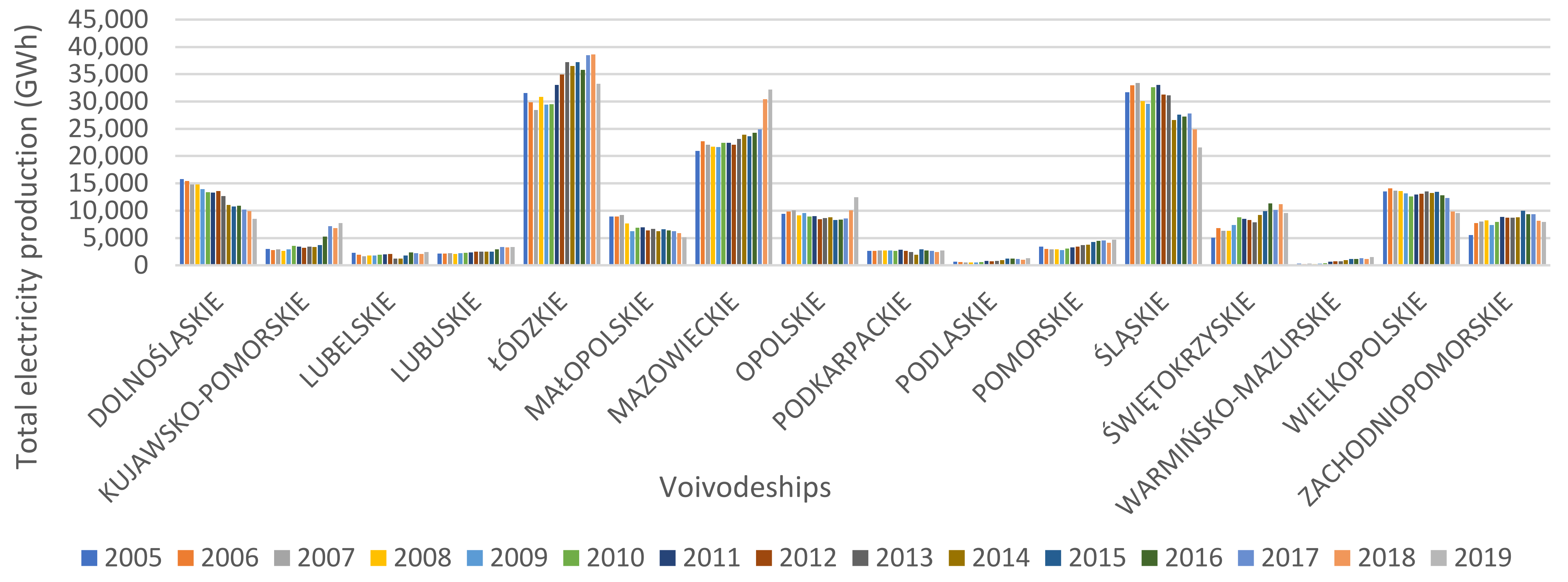
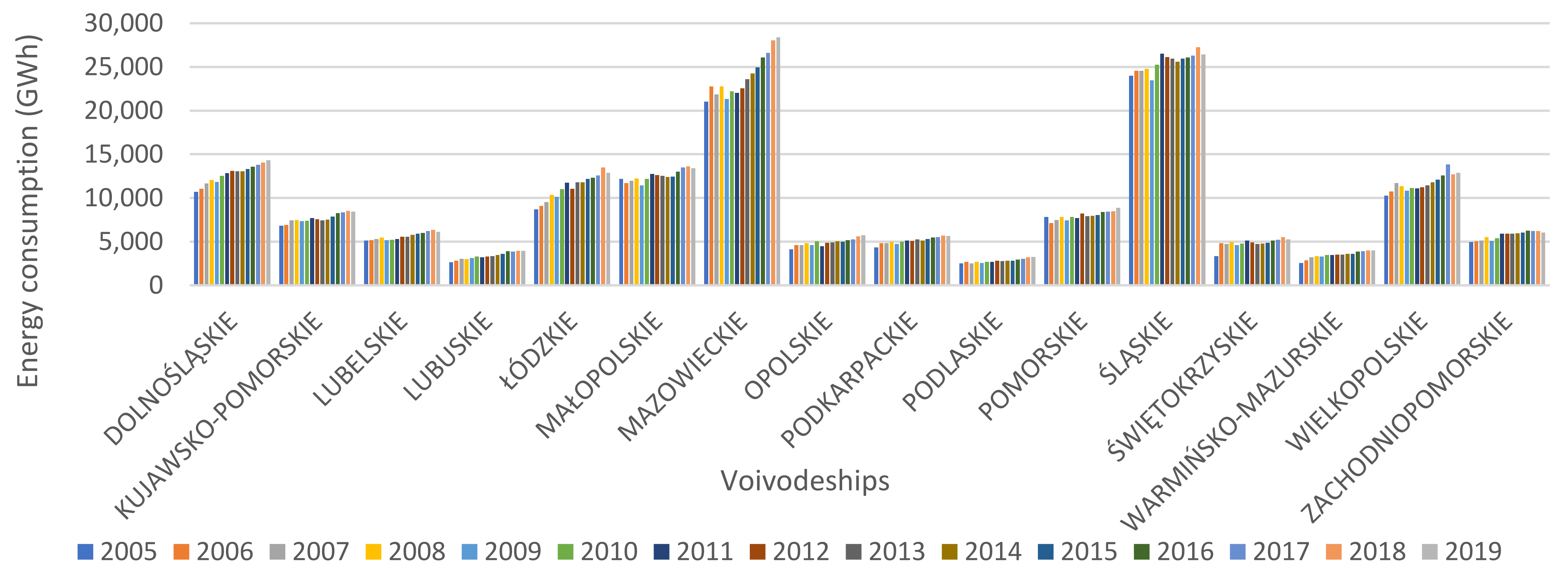

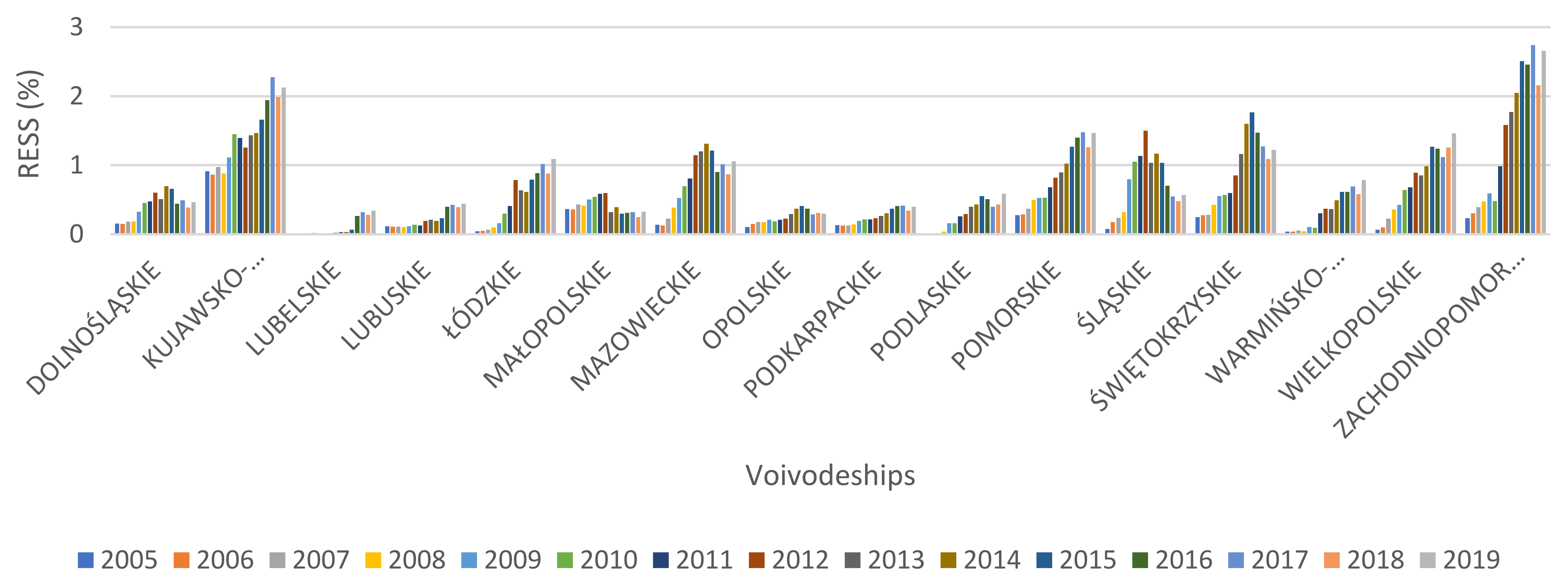
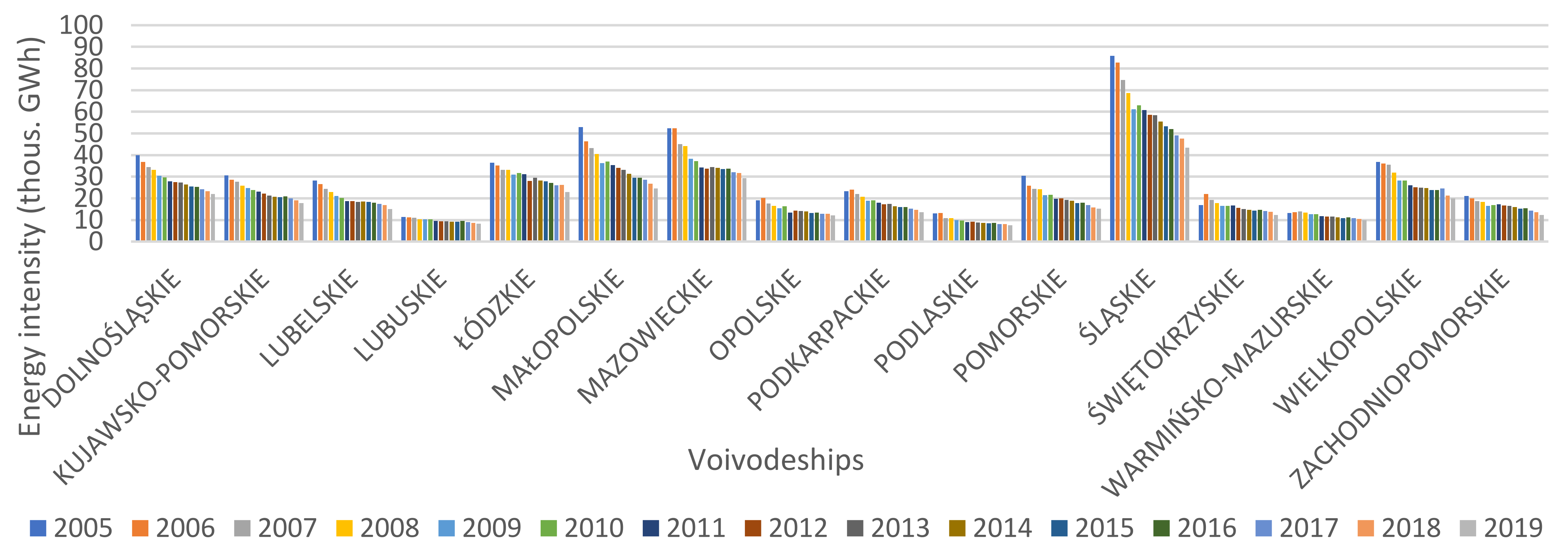
Appendix C
| Variable | Mean | Median | Min | Max | SD | RSD | Skewness | Kurtosis |
|---|---|---|---|---|---|---|---|---|
| RESS | 0.778 | 0.593 | 0.01 | 2.74 | 0.581 | 0.747 | 1.195 | 1.119 |
| GDPPC | 42.492 | 39.651 | 25.993 | 96.579 | 12.089 | 0.284 | 1.649 | 3.566 |
| HEC | 1.792 | 1.423 | 0.658 | 4.849 | 1.081 | 0.603 | 1.252 | 0.864 |
| NHEC | 7.894 | 5.486 | 1.822 | 23.753 | 5.891 | 0.746 | 1.424 | 1.108 |
| PEH | 0.636 | 0.64 | 0.56 | 0.7 | 0.033 | 0.051 | −0.218 | −0.515 |
| PC | 807.2 | 809.6 | 633.48 | 947.87 | 63.97 | 0.079 | −0.031 | −0.219 |
| PGH | 53.088 | 53.46 | 40.16 | 64.23 | 5.509 | 0.104 | −0.257 | −0.73 |
| R&D | 328.95 | 179.63 | 0 | 1855.4 | 382.68 | 1.163 | 1.85 | 3.532 |
| IEC | 2.542 | 1.952 | 0.143 | 7.561 | 2.135 | 0.84 | 1.084 | 0.042 |
| AEPC | 2.512 | 1.954 | 0.132 | 7.532 | 2.138 | 0.851 | 1.092 | 0.041 |
| PECD | 13.207 | 9.798 | 1.382 | 43.71 | 12.133 | 0.919 | 1.273 | 0.46 |
| EEPW | 57.357 | 21.516 | 0.092 | 954.45 | 105.29 | 1.836 | 4.88 | 33.264 |
References
- Transforming Our World: The 2030 Agenda for Sustainable Development. Available online: https://www.unfpa.org/resources/transforming-our-world-2030-agenda-sustainable-development (accessed on 4 October 2021).
- Directive 2009/28/EC of the European Parliament and of the Council of 23 April 2009 on the Promotion of the Use of Energy from Renewable Sources. Available online: https://eur-lex.europa.eu/legal-content/EN/ALL/?uri=celex%3A32009L0028 (accessed on 4 October 2021).
- Sadorsky, P. Renewable Energy Consumption, CO2 Emissions and Oil Prices in the G7 Countries. Energy Econ. 2009, 31, 456–462. [Google Scholar] [CrossRef]
- Marques, A.C.; Fuinhas, J.A.; Pires Manso, J.R. Motivations Driving Renewable Energy in European Countries: A Panel Data Approach. Energy Policy 2010, 38, 6877–6885. [Google Scholar] [CrossRef]
- Marques, A.C.; Fuinhas, J.A.; Manso, J.P. A Quantile Approach to Identify Factors Promoting Renewable Energy in European Countries. Environ. Resour. Econ. 2011, 49, 351–366. [Google Scholar] [CrossRef]
- Marques, A.C.; Fuinhas, J.A. Drivers Promoting Renewable Energy: A Dynamic Panel Approach. Renew. Sustain. Energy Rev. 2011, 15, 1601–1608. [Google Scholar] [CrossRef]
- Marques, A.C.; Fuinhas, J.A. Are Public Policies towards Renewables Successful? Evidence from European Countries. Renew. Energy 2012, 44, 109–118. [Google Scholar] [CrossRef]
- Aguirre, M.; Ibikunle, G. Determinants of Renewable Energy Growth: A Global Sample Analysis. Energy Policy 2014, 69, 374–384. [Google Scholar] [CrossRef] [Green Version]
- Omri, A.; Nguyen, D.K. On the Determinants of Renewable Energy Consumption: International Evidence. Energy 2014, 72, 554–560. [Google Scholar] [CrossRef]
- Graczyk, A. Development of Renewable Energy Sources in Polish Regional Policy. Barom. Reg. Anal. Progn. 2020, 15, 55–59. [Google Scholar]
- Tiba, S.; Omri, A. Literature Survey on the Relationships between Energy, Environment and Economic Growth. Renew. Sustain. Energy Rev. 2017, 69, 1129–1146. [Google Scholar] [CrossRef]
- Papież, M.; Śmiech, S.; Frodyma, K. Determinants of Renewable Energy Development in the EU Countries. A 20-Year Perspective. Renew. Sustain. Energy Rev. 2018, 91, 918–934. [Google Scholar] [CrossRef]
- He, Z.-X.; Xu, S.-C.; Li, Q.-B.; Zhao, B. Factors That Influence Renewable Energy Technological Innovation in China: A Dynamic Panel Approach. Sustainability 2018, 10, 124. [Google Scholar] [CrossRef] [Green Version]
- Sysko-Romańczuk, S.; Kluj, G. Mikrosieci jako innowacyjny komponent dywersyfikacji rynku energetycznego w Polsce. PO 2019, 19–24. [Google Scholar] [CrossRef]
- Jarno, K. Renewable Energy Drivers in the European Union—Evidence from the Panel Data Threshold Regression Model. Bank Kredyt 2020, 51, 505–516. [Google Scholar]
- Miskinis, V.; Galinis, A.; Konstantinaviciute, I.; Lekavicius, V.; Neniskis, E. Comparative Analysis of Energy Efficiency Trends and Driving Factors in the Baltic States. Energy Strategy Rev. 2020, 30, 100514. [Google Scholar] [CrossRef]
- Miškinis, V.; Galinis, A.; Konstantinavičiūtė, I.; Lekavičius, V.; Neniškis, E. The Role of Renewable Energy Sources in Dynamics of Energy-Related GHG Emissions in the Baltic States. Sustainability 2021, 13, 10215. [Google Scholar] [CrossRef]
- Serowaniec, M. Sustainable Development Policy and Renewable Energy in Poland. Energies 2021, 14, 2244. [Google Scholar] [CrossRef]
- Tomaszewski, K.; Sekściński, A. Odnawialne Źródła Energii w Polsce—Perspektywa Lokalna i Regionalna. Rynek Energii 2020, 4, 10–19. [Google Scholar]
- The Paris Agreement|UNFCCC. Available online: https://unfccc.int/sites/default/files/english_paris_agreement.pdf (accessed on 4 October 2021).
- COP26 Goals. Available online: https://ukcop26.org/cop26-goals/ (accessed on 4 October 2021).
- As G7 Calls Time on Coal, Have You Checked Your Supply Chain? Available online: https://www.weforum.org/agenda/ 2021/06/g7-coal-have-you-checked-your-supply-chain/ (accessed on 4 October 2021).
- Commission Implementing Regulation (EU) 2020/1294 of 15 September 2020 on the Union Renewable Energy Financing Mechanism (Text with EEA Relevance). Available online: http://data.europa.eu/eli/reg_impl/2020/1294/oj/eng (accessed on 4 October 2021).
- National Energy and Climate Plan for the Years 2021–2030—Ministerstwo Klimatu i Środowiska—Portal Gov.pl. Available online: https://www.gov.pl/web/klimat/national-energy-and-climate-plan-for-the-years-2021-2030 (accessed on 4 October 2021).
- Energy Policy of Poland Until 2040—Portal Gov.pl. Available online: https://www.gov.pl/web/klimat/polityka-energetyczna-polski (accessed on 4 October 2021).
- Ministry of State Treasury of the Republic of Poland Information for Q4 2019 on the Use of Energy from Renewable Sources. Available online: https://www.gov.pl/web/klimat/2019-r3 (accessed on 4 October 2021).
- Ministry of Climate and Environment Poland. 2021 National Inventory Report (NIR)|UNFCCC. Available online: https://unfccc.int/documents/274762 (accessed on 4 October 2021).
- Statistics|Eurostat Primary Energy Consumption. Available online: https://ec.europa.eu/eurostat/databrowser/view/ SDG_07_10/bookmark/line?lang=en&bookmarkId=0288fb5b-f38c-4b5e-8f28-65576ba025c9 (accessed on 4 October 2021).
- Statistics Poland Primary Energy Consumption of GDP with Climate Correction. Available online: https://sdg.gov.pl/ (accessed on 4 October 2021).
- Enerdata GDP & Primary Consumption Trends|Primary Consumption and GDP in Europe|ODYSSEE-MURE. Available online: https://www.odyssee-mure.eu/publications/efficiency-by-sector/overview/primary-consumption-gdp-trends.html (accessed on 4 October 2021).
- IRENA. Renewable Power Generation Costs in 2019; International Renewable Energy Agency (IRENA): Abu Dhabi, United Arab Emirates, 2020; ISBN 978-92-9260-244-4. [Google Scholar]
- Agencja Rynku Energii S.A. Bilans Energii Pierwotnej w Latach 2005–2020. Available online: https://www.are.waw.pl/component/phocadownload/category/21-bilans-energii-pierwotnej?download=70:bilans-energii-pierwotnej-w-latach-2005-2020 (accessed on 4 October 2021).
- PGE Polska Grupa Energetyczna SA, P.S. O Oddziale (Oddział Elektrownia Bełchatów). Available online: https://elbelchatow.pgegiek.pl/o-oddziale (accessed on 4 October 2021).
- EN. Directive (EU) 2018/2001 of the European Parliament and of the Council of 11 December 2018 on the Promotion of the Use of Energy from Renewable Sources (Text with EEA Relevance). Off. J. Eur. Union 2018, L328, 82–209. [Google Scholar]
- Arellano, M.; Bond, S. Some Tests of Specification for Panel Data: Monte Carlo Evidence and an Application to Employment Equations. Rev. Econ. Stud. 1991, 58, 277–297. [Google Scholar] [CrossRef] [Green Version]
- Arellano, M.; Bover, O. Another Look at the Instrumental Variable Estimation of Error-Components Models. J. Econometr. 1995, 68, 29–51. [Google Scholar] [CrossRef] [Green Version]
- Baltagi, B.H. Econometric Analysis of Panel Data, 4th ed.; Wiley: Chichester, UK; Hoboken, NJ, USA, 2008; Chapter 8; ISBN 978-0-470-51886-1. [Google Scholar]
- The Energy Regulatory Office of the Republic of Poland. Sprawozdanie z Działalności Urzędu Regulacji Energetyki za 2019 Rok (Report on the Activities of the Energy Regulatory Office for 2019). Available online: https://www.ure.gov.pl/ pl/urzad/informacje-ogolne/aktualnosci/8861,Sprawozdanie-z-dzialalnosci-Urzedu-Regulacji-Energetyki-za-2019-rok.html (accessed on 5 October 2021).
- Supreme Audit Office. NIK about Barriers in Development of Renewable Energy Sources—Supreme Audit Office. Available online: https://www.nik.gov.pl/en/news/nik-about-barriers-to-the-development-of-renewable-energy-sources.html (accessed on 5 October 2021).
- Aflaki, S.; Basher, S.A.; Masini, A. Does Economic Growth Matter? Technology-Push, Demand-Pull and Endogenous Drivers of Innovation in the Renewable Energy Industry; Social Science Research Network: Rochester, NY, USA, 2014. [Google Scholar]
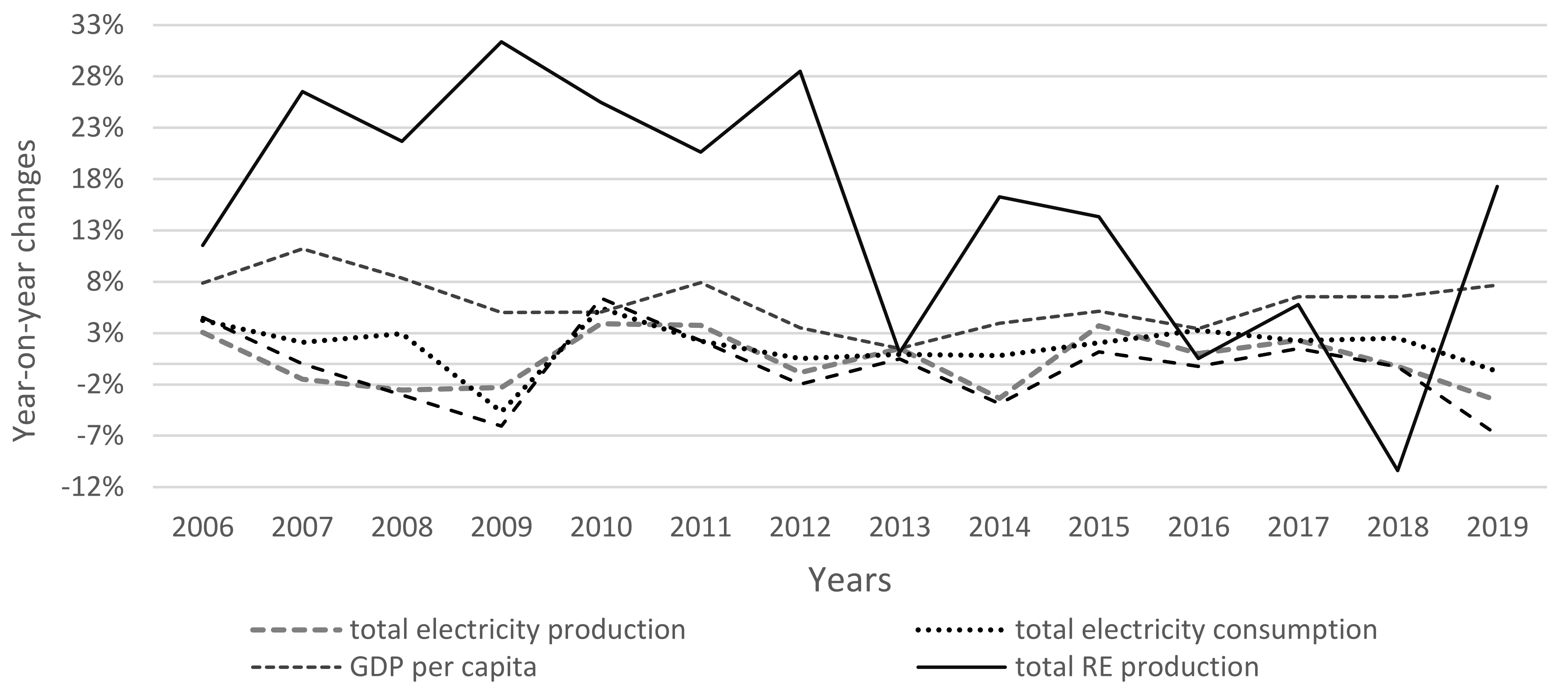
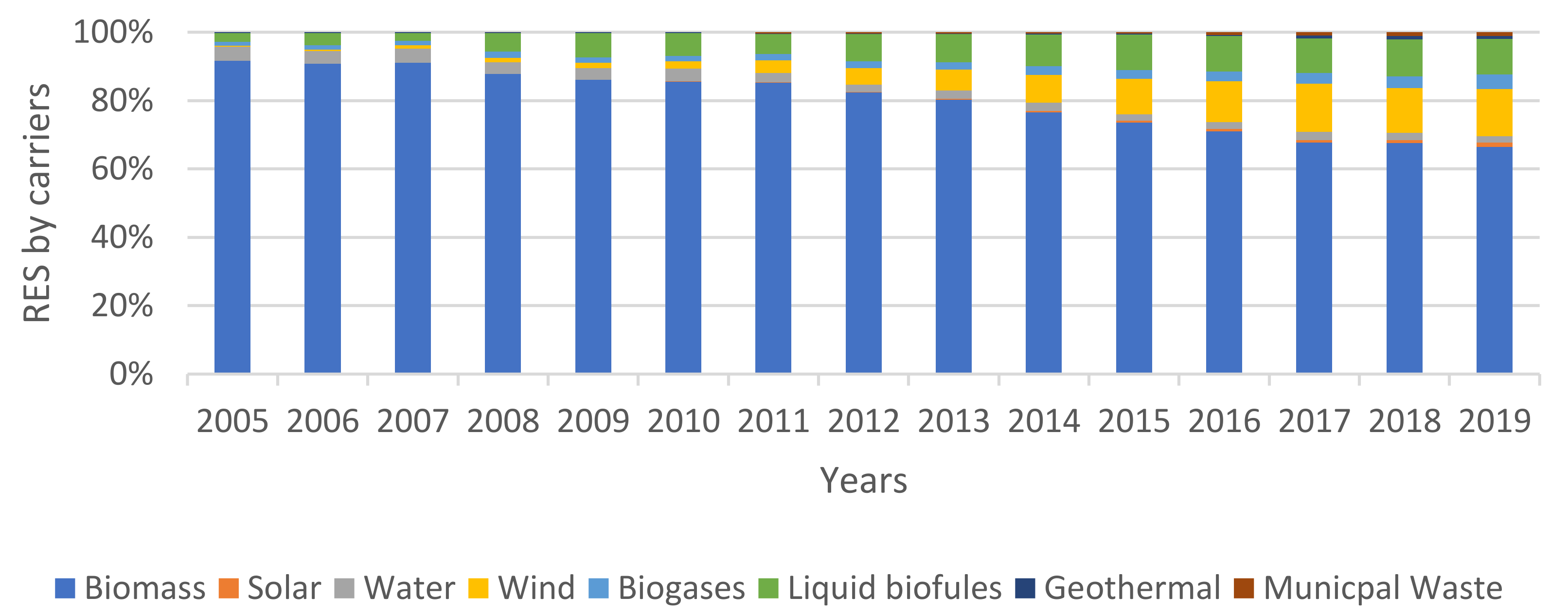
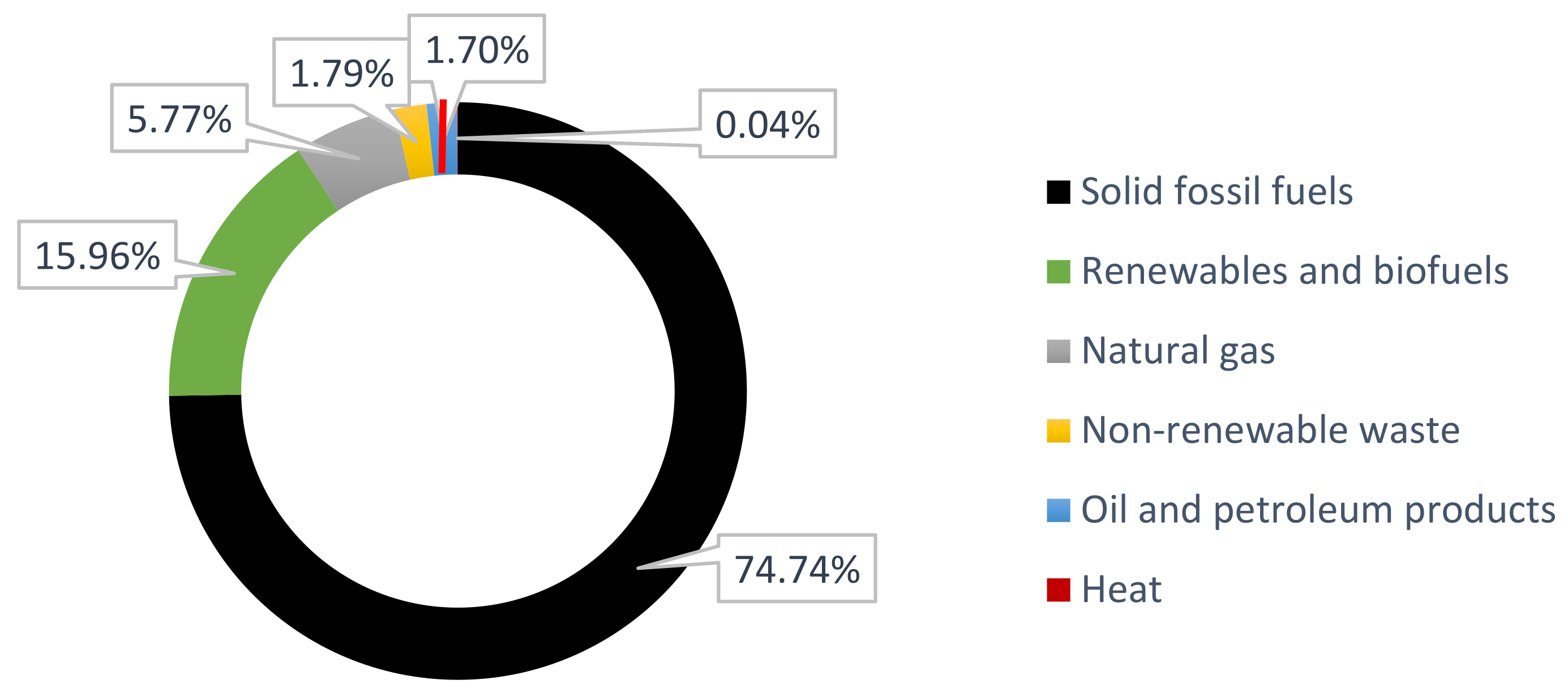
| Study | Country/Region | Period | Method | Main Findings |
|---|---|---|---|---|
| Sadorsky (2009) [3] | G7 countries | 1980–2005 | Panel cointegration techniques | Positive impact of real GDP per capita and carbon dioxide emissions per capita on renewable energy consumption and negative impact of oil prices on renewable energy consumption. |
| Marques et al. (2010) [4] | 24 European Union countries | 1990–2006 | Panel data techniques | Driving factors of RE deployment are identified: EU membership and adoption of Directive 2001/77/EC, effects of lobby pressure, energy self-sufficiency, CO2 emissions, and income. |
| Marques et al. (2011) [5] | 24 European Union countries | 1990–2006 | Quantile regression | There is a significant difference in response to the drivers that affect renewable sources adoption suggesting the existence of an initial barrier due to the initial contribution of RE: the industry lobbying (the lobbies of the traditional fossil fuels) negative effect is more profound for low levels of RE use than for high RE commitments. Income revealed to be a significant driver to boost the use of renewable resources in the early stage of commitment with renewables; however, higher income could imply additional energy consumption from the fossil sources presently available in the market. |
| Marques et al. (2011) [6] | 24 European countries | 1990–2006 | Panel dynamic estimators | The level of renewable energy use in the previous period has a positive and highly significant effect on the current level of use. Traditional energy sources restrain deployments of renewables. Social awareness of sustainability, climate change mitigation, and CO2 reduction targets cannot effectively cause a transition to renewable energy sources. Market factors (income and prices of fossil-based fuels) were not significant for developing renewables in 1990–2006. |
| Marques et al. (2012) [7] | 23 European countries | 1990–2007 | Panel Corrected Standard Errors estimator | Policies of incentives/subsidies (including feed-in tariffs) and policy processes are significant drivers of improved renewables use. |
| Aguirre and Ibikunle (2014) [8] | OECD and BRICS countries | 1990–2010 | Fix effects vector decomposition (FEVD) and panel-corrected standard error (PCSE) estimation | Environmental concerns (CO2 emission levels) are more relevant than energy security. Energy use is negatively linked to renewable energy participation and high electricity rates for the industry sector. There is a negative relationship between renewables participation and the composition of coal, oil, natural gas, and nuclear power in the energy mix. A negative influence of typically used political factors (Voluntary Approaches and Fiscal and Financial Instruments) suggests failures in the design of RE deployment policies that create nonacceptable uncertainty for potential RE investors. |
| Omri and Nguyen (2014) [9] | 64 countries | 1990–2011 | Dynamic panel data model | Increases in CO2 emissions and trade openness are the primary drivers of renewable energy consumption. Oil price increases have a more minor but negative impact on renewable energy consumption. |
| Graczyk (2017) [10] | Poland | 2010–2030 | Descriptive analysis, analysis of sources of law, development projections based on empirical data | The development of RES can be an essential factor in the development of distributed energy, particularly prosumer energy, which may contribute to regions’ development. However, it requires financial, administrative, and organizational support. Because of the insufficiency of state aid (especially financial aid), the regions should support the development of the RES sector. |
| Tiba and Omri (2017) [11] | 264 research results from the world literature | 1978–2014 | Comparative analysis, systematization of knowledge. | There is a consensus on the seriousness of the relationship between electricity production, environmental change, and economic growth. |
| Papież et al. (2018) [12] | 26 EU countries | 1995–2014 | Best subset regression; LARS method | The main factors of RES development are GDP per capita, the concentration of energy supply, the costs of energy consumption obtained from fossil fuels in relation to GDP, and three components that divide the analyzed countries into (1) the ones using or not using coal or crude oil as their main energy sources; (2) countries using natural gas as their primary energy source; and (3) countries that use clean energy as their main energy source and only limited amounts of dirty energy sources. |
| He et al. (2018) [13] | 29 provinces of China | 2006–2013 | Dynamic panel | Electricity consumption is the most important driver for all renewables and wind energy, but the driving effect was weaker for solar energy and biomass. |
| Sysko-Romańczuk, Kluj (2019) [14] | Poland | 1999–2019 | Research triangulation of microgrid development processes | The main factors determining the development of RES are falling costs of RES production and energy storage, rising rates of electricity charges, and increasingly decisive political efforts to reduce greenhouse gas emissions while promoting distributed energy resources. |
| Jarno (2020) [15] | EU member states | 2009–2017 | Nondynamic panel threshold regression model with individual-specific fixed effects | There is a threshold for the GDP growth rate, from which the impact of energy prices on the growth rate of the share of RES in gross final energy consumption in the EU Member States is visible. When the GDP growth rate is more than 3.1% per year, rising energy prices positively impact the growth rate of the share of renewable energy in gross final energy consumption. |
| Miškinis et al. (2020) [16] | Baltic States | 2000–2018 | Fisher Ideal Index | Changes in energy intensity are analyzed in each country on three stages: primary energy intensity, final energy intensity, and sectoral energy intensity. High energy conversion losses in Estonia, a high share of energy-intensive industries, and a rapid increase of energy consumption in the Lithuanian transport sector are identified as limiting the further increase of energy efficiency. |
| Miškinis et al. (2021) [17] | Baltic See Region (BSR) | 2010–2019 | The Kaya identity and the logarithmic mean Divisia index (LMDI) | The impact of population change, economic growth, decline of energy intensity, RES deployment, and emission intensity reduction on change of GHG emissions in countries of the BSR and, on average, in the EU-27 during 2010–2019 is revealed. Some energy policy recommendations are formulated. |
| Serowaniec (2021) [18] | Poland | 1997–2020 | Descriptive methods and the interpretation of legal acts and court decisions. | The state authorities should take further specific actions to achieve the sustainable development of the renewable energy sector in Poland. These actions should be primarily aimed at gradually converting electricity production from coal to renewable energy sources, and moving away from fossil fuels for heat production in favor of RES. |
| Variable | Description | Units |
|---|---|---|
| GDPPC | Gross domestic product per capita | (thous. PLN) |
| HEC | Household electricity consumption | (thous. GWh) |
| NHEC | Nonhousehold electricity consumption | (thous. GWh) |
| PEH | Average prices of electricity for households (G-11 tariff) per 1 kWh | (PLN) |
| PC | Price of one ton of hard coal | (PLN) |
| PGH | Price of gas for households consumers propane–butane, cylinder, capacity 11 kg of liquefied gas (no delivery fee) | (PLN) |
| R&D | Innovation expenditure related to research and development (R&D), acc. to LDB | (mln. PLN) |
| IEC | Total installed electric capacity of connections | (thous. MWh) |
| APEC | Total achievable electric power capacity | (thous. MWh) |
| PECD | Pollution emission (carbon dioxide) | (mln. t/y) |
| EEPW | Total expenditures on environmental protection and water management 1 | (mln. PLN) |
| RESS in the previous period | (%) |
| Variable | 2010 | 2011 | 2012 | 2013 | 2014 | 2015 | 2016 | 2017 | 2018 | 2019 |
|---|---|---|---|---|---|---|---|---|---|---|
| RESS | RESS | RESS | RESS | RESS | RESS | RESS | RESS | RESS | RESS | |
| GDPPC | 0.39 | 0.39 | 0.47 | 0.34 | 0.30 | 0.2 | 0.06 | 0.06 | 0.09 | 0.09 |
| PEH | −0.6 | −0.56 | −0.39 | −0.14 | −0.02 | 0.09 | 0.26 | 0.16 | 0.16 | 0.3 |
| PECD | 0.4 | 0.38 | 0.54 | 0.3 | 0.26 | 0.17 | 0.06 | 0.02 | 0.02 | 0.03 |
| R&D | 0.49 | 0.35 | 0.32 | 0.14 | 0.11 | 0.01 | −0.27 | −0.16 | −0.2 | −0.23 |
| IEC | 0.46 | 0.47 | 0.65 | 0.43 | 0.41 | 0.31 | 0.19 | 0.19 | 0.19 | 0.15 |
| AEPC | 0.45 | 0.46 | 0.64 | 0.42 | 0.38 | 0.31 | 0.19 | 0.19 | 0.18 | 0.14 |
| PC | −0.16 | −0.06 | 0.01 | 0.12 | 0.16 | 0.15 | 0.2 | 0.1 | 0.17 | 0.11 |
| PGH | 0.19 | −0.07 | −0.04 | −0.06 | −0.12 | −0.02 | −0.07 | −0.05 | −0.23 | −0.08 |
| HEC | 0.47 | 0.46 | 0.5 | 0.28 | 0.24 | 0.09 | −0.04 | −0.04 | −0.02 | −0.01 |
| NHEC | 0.55 | 0.54 | 0.59 | 0.32 | 0.29 | 0.14 | −0.03 | −0.04 | −0.05 | −0.04 |
| EEPW | 0.3 | 0.34 | 0.36 | 0.32 | 0.36 | −0.09 | −0.1 | 0.22 | −0.05 | 0.02 |
| RESt−1 | 0.97 | 0.94 | 0.93 | 0.93 | 0.99 | 0.98 | 0.96 | 0.98 | 0.99 | 0.99 |
| Variables | Coefficient | Stand. Error | |
|---|---|---|---|
| Intercept | 0.3666 *** | 0.0599 | |
| 0.1533 *** | 0.0283 | ||
| 0.1278 *** | 0.0382 | ||
| −0.075 *** | 0.0125 | ||
| 0.7674 *** | 0.0457 | ||
| du_2 | 0.2275 *** | 0.0633 | |
| du_3 | −0.1797 *** | 0.0627 | |
| du_4 | −0.1946 *** | 0.0615 | |
| du_5 | −0.4923 *** | 0.1027 | |
| du_6 | −0.1202 ** | 0.0569 | |
| du_8 | −0.3434 *** | 0.0688 | |
| du_9 | −0.2151 *** | 0.0595 | |
| du_10 | −0.2051 *** | 0.0609 | |
| du_14 | −0.1248 ** | 0.0584 | |
| du_15 | −0.1365 ** | 0.0569 | |
| dt_1 | −0.1181 *** | 0.0411 | |
| dt_2 | −0.0860 ** | 0.0397 | |
| dt_4 | −0.1164 *** | 0.0379 | |
| dt_7 | −0.0803 ** | 0.0389 | |
| dt_9 | −0.1689 *** | 0.0389 | |
| Adjusted R-square | 0.944 | Akaike criterion | −161.455 |
| Bayes–Schwarz criterion | −99.951 | Hannana−Quinn | −136.480 |
| Autocor. residual-rho1 | −0.010 | Durbin−Watson | 1.679 |
| Wooldridge test for autocorrelation: H0: no first−order autocorrelation (rho = 0); test statistic: t(15) = −0.1783, p-value = 0.8609 | |||
| Chow test for structural change and stability, structural break 6:10 H0: no structural change, F(11, 129) = 1.4899, p-value = 0.1427 | |||
| Levin−Lin−Chu test for panel data model | |||
| H0: Panels contain unit roots | |||
| Ha: Panels are stationary | |||
| Coeff. | t-Student | z-score | |
| 1.1702 | −13.718 | −10.5422 (0.000) | |
Publisher’s Note: MDPI stays neutral with regard to jurisdictional claims in published maps and institutional affiliations. |
© 2021 by the authors. Licensee MDPI, Basel, Switzerland. This article is an open access article distributed under the terms and conditions of the Creative Commons Attribution (CC BY) license (https://creativecommons.org/licenses/by/4.0/).
Share and Cite
Bednarczyk, J.L.; Brzozowska-Rup, K.; Luściński, S. Determinants of the Energy Development Based on Renewable Energy Sources in Poland. Energies 2021, 14, 6762. https://doi.org/10.3390/en14206762
Bednarczyk JL, Brzozowska-Rup K, Luściński S. Determinants of the Energy Development Based on Renewable Energy Sources in Poland. Energies. 2021; 14(20):6762. https://doi.org/10.3390/en14206762
Chicago/Turabian StyleBednarczyk, Jan L., Katarzyna Brzozowska-Rup, and Sławomir Luściński. 2021. "Determinants of the Energy Development Based on Renewable Energy Sources in Poland" Energies 14, no. 20: 6762. https://doi.org/10.3390/en14206762
APA StyleBednarczyk, J. L., Brzozowska-Rup, K., & Luściński, S. (2021). Determinants of the Energy Development Based on Renewable Energy Sources in Poland. Energies, 14(20), 6762. https://doi.org/10.3390/en14206762







